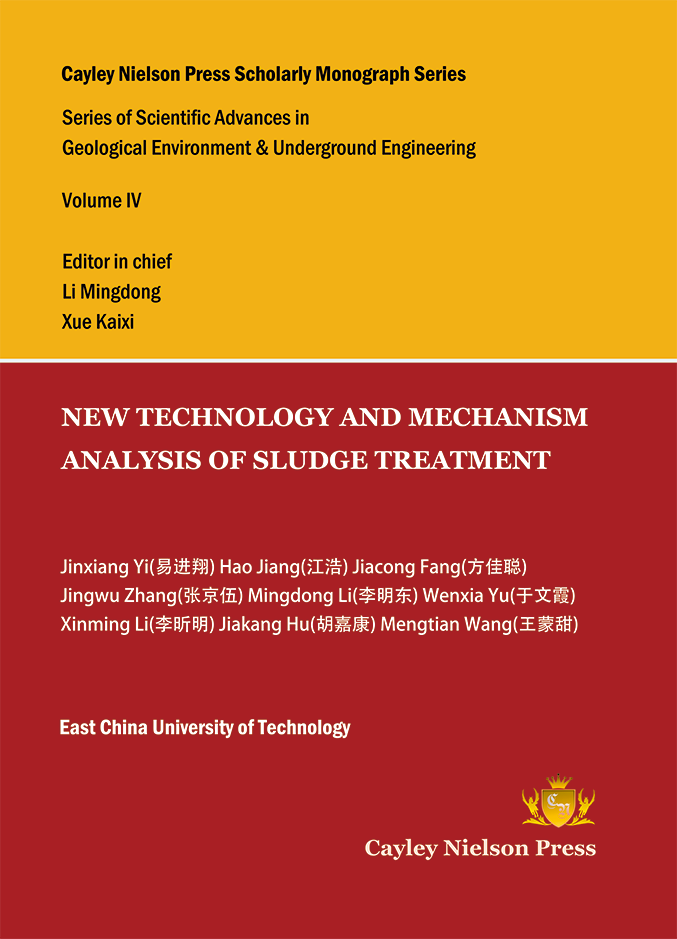
NEW TECHNOLOGY AND MECHANISM ANALYSIS OF SLUDGE TREATMENT

NEW TECHNOLOGY AND MECHANISM ANALYSIS OF SLUDGE TREATMENT
Jinxiang Yi(易进翔),Hao Jiang(江浩),Jiacong Fang(方佳聪),Jingwu Zhang(张京伍),Mingdong Li(李明东),Wenxia Yu(于文霞),Xinming Li(李昕明),Jiakang Hu(胡嘉康),Mengtian Wang(王蒙甜)
East China University of Technology
Copyright © 2022 by Cayley Nielson Press, Inc.
ISBN: 978-1-957274-06-5
Cayley Nielson Press Scholarly Monograph Series Book Code No.: 212-4-5
Series of Scientific Advances in Geological Environment & Underground Engineering, Volume IV
Editor in chief: Li, Mingdong and Xue, Kaixi(李明东,薛凯喜)
Editors: Yi, Jinxiang; Zhang, Jingwu; Zhu, Liping; Yang, Ting; Xu, Tao; Wang, Shengfu; Shan, Lingzhi; Wan, Yukuai (易进翔,张京伍,朱丽萍,杨婷,许涛,王升福,单凌志,万愉快)
US$150.00
Preface
Since the sustainable development strategy was put forward, environmental governance has become one of the most concerned issues in the core area of the public. With the continuous improvement of sewage treatment technology, the problem of water pollution is gradually transformed into the problem of mud pollution, in which the treatment and disposal of sludge are particularly complex, which has become another mountain of environmental protection. Sludge composition is intricate, physical and mechanical properties are special, sludge treatment and disposal is a typical environmental geotechnical problem, need to adopt a variety of technical means for mud treatment and disposal.
The contents of this book are from the mud treatment research achievements completed by the author and his team in recent years, including the National Natural Science Foundation of China (51478167), the Science and technology research project of Education Department of Jiangxi Province (GJJ180386), the Doctoral Research Start-up Fund project of East China Institute of Technology (DHBK2018048), more than 10 patents, and related papers, etc. The results of this book can innovate the theory of sludge treatment and disposal technology, solve the problems of sludge treatment in engineering practice, provide new methods for the improvement of sludge mechanics, and provide new power for sustainable development strategy in the application level.
This book by Yi Jinxiang responsible for the draft, which Hao Jiang、Jiacong Fang、Jingwu Zhang are responsible for Chapter 1, Chapter 6 preparations, Jinxiang Yi、Mingdong Li、Wenxia Yu are responsible for Chapter 2, Chapter 3 preparation, Xinming Li、Jiakang Hu、Mengtian Wang are responsible for Chapter 4, Chapter 5 preparations.
Due to the complexity of sludge composition and the difficulty of treatment, it is a multidisciplinary environmental geotechnical engineering subject, and many problems and research methods need to be further improved. Due to the limitations of the author's level, it is inevitable that there are some inside quotes in the book, and readers' criticism and correction are sincerely welcome.
Contents
Chapter 1 Introduction 1
1.1 Present situation of sludge treatment and disposal 1
1.2 Technical problems existing in sludge landfill disposal 1
Chapter 2 Study on Consolidation and Compression Characteristics of Sludge 4
2.1 Study on compression characteristics of solidified sludge 4
2.2.1 Study on compression test 5
2.1.2 Experimental conclusion and analysis 7
2.1.3 Conclusion 13
2.2 Experimental study on combined treatment of sludge by chemical conditioning and Pressurized Vacuum Preloading 13
Chapter 3 Study on compaction characteristics of sludge 34
3.1 Study on compaction characteristics of solidified sludge in landfill disposal 34
3.1.1 Test materials, arrangements and methods 35
3.1.2 Test results 37
3.1.3 Conclusion 41
Chapter 4 Study on strength characteristics of sludge 42
Chapter 5 Study on degradation characteristics of sludge 72
5.1 Study on degradation of organic matter in sludge 72
5.1.1 Degradation test of organic matter 74
5.1.2 Test results and analysis 76
5.1.3 Conclusion 80
5.2 Study on degradation law of sludge solidified soil in landfill disposal 80
5.2.1 Study on degradation test of organic matter 82
5.2.2 Test conclusions and analysis 84
5.2.3 Conclusion 88
Chapter 6 Microscopic mechanism analysis of sludge 90
6.1 Calculation method of three-dimensional porosity and fractal dimension of solidified sludge microstructure based on GIS 90
6.1.1 Sample preparation 92
6.1.2 Three-dimensional porosity and three-dimensional fractal of microstructure 93
6.1.3 The rationality of the calculation method of three-dimensional porosity and fractal dimension of microstructure 103
6.1.4 Conclusions 104
Chapter 7 Sludge treatment technology and application 123
7.1 Sample preparation apparatus and sample preparation method for laboratory test of sludge solidification treatment 123
7.1.1 Composition of device 123
7.1.2 Operating principle 124
7.1.3 Mode of operation 125
7.1.4 Specific implementation 126
7.2 A large single shear instrument for sludge-domestic waste mixed landfill and its test method 129
7.2.1 Composition of device 129
7.2.2 Operating principle 130
7.2.3 Mode of operation 131
7.2.4 Specific implementation 133
7.3 Biochemical degradation test device for mixed landfill column of municipal solid waste and sludge 135
7.3.1 Composition of device 135
7.3.2 Operating principle 135
7.3.3 Mode of operation 138
7.3.4 Specific implementation 139
References 141
Readership
This book should be useful for students, scientists, engineers and professionals working in the areas of optoelectronic packaging, photonic devices, semiconductor technology, materials science, polymer science, electrical and electronics engineering. This book could be used for one semester course on adhesives for photonics packaging designed for both undergraduate and graduate engineering students.
